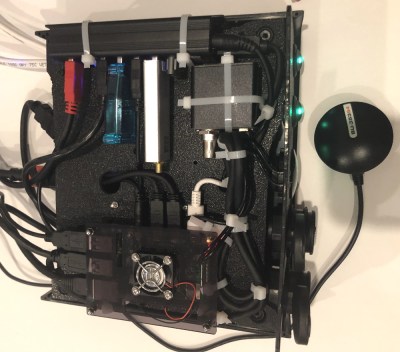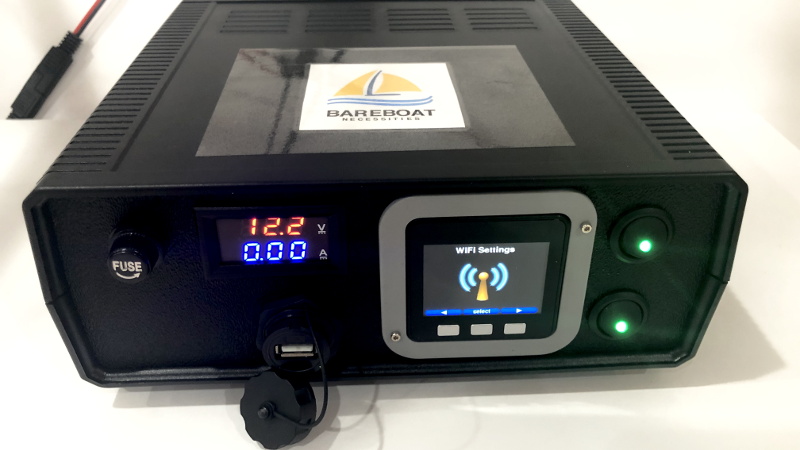We’re not sure how many of you out there own a boat large enough to get its own integrated computer network, but it doesn’t really matter. Even if you can’t use this project personally, it’s impossible not to be impressed with the work [mgrouch] has put into the “Bareboat Necessities” project. From the construction of the hardware to the phenomenal documentation, there’s plenty that even landlubbers can learn from this project.
In its fully realized form, the onboard computer system includes several components that work together to provide a wealth of valuable information to the operator.

What [mgrouch] calls the “Boat Computer” contains a Raspberry Pi 4, a dAISy AIS receiver, an RTL-SDR, a GPS receiver, serial adapters, and the myriad of wires required to get them all talking to each other inside a weatherproof enclosure. As you might expect, this involves running all the connections through watertight panel mounts.
Combined with a suite of open source software tools, the “Boat Computer” is capable of interfacing with NMEA sensors and hardware, receive weather information directly from NOAA satellites, track ships, and of course plot your current position on a digital chart. The computer itself is designed to stay safely below deck, while the operator interacts with it through an Argonaut M7 waterproofed HDMI touch screen located in the cockpit.
For some people, that might be enough. But for those who want to do big, [mgrouch] further details the “Boat Gateway” device. This unit contains an LTE-equipped WiFi router running OpenWrt and all the external antennas required to turn the boat into a floating hotspot. Of course it also has RJ45 jacks to connect up to the other components of the onboard system, and it even includes an M5Stack Core with LAN module so it can display a select subset of sensor readings and navigational data.
If you’d like to do something similar on a slightly smaller scale, we’ve seen sailing computers that pushed all the data to a wearable display or even a repurposed eReader.
















What kind of boat is too small for computer networks? This is HaD we’re talking about!
I would say Benchy is the benchmark for too small, maybe
Now I want to make an RC benchy!
RJ45 connectors!
After a couple of months all the pins will be numbered pin 5 if you read their color code.
That and sitting in the sun will surely degrade the vinyl jacket to powder. I bought a bunch of old boating stuff cheap from a store shutting down–radars, nav computers, sensors, antennas, battery chargers, you name it. All a $1 an item, but most of it was well beaten. The one thing I noticed was the wiring they used was like a really heavy vinyl material. All of it seemed to be perfect. However, some cheap computer speakers were in the lot and the jacket over the wire was falling apart like it was made of sandstone. UV and salt really wreck things. I’m not too certain those RJ45 jacks or wiring bundles will survive if any part of it gets exposure to the sun and air.
On most proper marine electronics I’ve seen that had RJ-45 connectors, the specified cables had heavy-duty jackets and molded boots that covered and “locked’ the RJ45 connector in place. Hopefully protecting against the deterioration from UV and saltwater.
Does anyone else miss the days when the plural was antennae?
/s
Seriously cool project – if I ever build my retro steam launch, this is going in it!
I’ve always understood that when talking about an insect’s sensing organs, one would pluralize antenna to antennae. When referring to bits of aluminum and steel stuck in the air to transmit and receive radio waves with, one would pluralize those to antennas.
Of course, I could be wrong. Also, this could be a regional thing. Around here (New England), almost all the hams I’ve spoken to use “antennas”, but I already had this use in my vocabulary before becoming a ham 12 years ago, so it’s possible I learned it in school back in the dawn of time.
Not to be that guy, but Amercans are known to manhandle English quite badly, and Ham’s especially.
They call theit mast’s “towers” and their towers “mast”
They also give each other “best 73’s”..
Atleast I can blame it on English not being my native language
In America we do not speak English, we speak Americanized English. There are lots of subtle differences but the main thing is it’s not too hard to figure out what the other is saying. 😀
What do you mean?
I don’t understand.
I speak Australian English.
Rob, still easy to understand than Jamaican English for a non-native English speaker like me :P
I highly doubt the enclosure is weatherproof. The rating of it is ip54. Also the fuse holder and switched are ip22 by the looks.
According the original post only th monitor is weatherproof.
i would love to see some DIY side scan mapping projects, with wifi fish finders as cheap as chips these days a, sure someone can come up with the math to combine two or more for sonar mapping.
Thats a nicely documented project, though it looks like its going to draw quite a chunk of power. Ok on a motor boat, but difficult when sailing when the 12V house batteries need to last for many hours, sometimes even days with minimal charging opportunities when racing for example. I’ve got most of these bits in various forms on a sailing boat, they are all good projects and its nice to see themn brought together, but the biggest challenge is a cockpit weather-proof screen that can be read in sunlight, thats not too bright at night, and sips minute amounts of power. I guess theres a reason why commercial marine instruments cost a packet.
Yes, I’ve been looking for a small sailboat with a weekend cuddy cabin. Figured out it needs quite a big battery to keep a VHF radio going, and even then you can’t be gabby on it. (Transmit eats the watts) Can only probably get 40W of solar on something small. Trying to figure out if I want to put a CB in as well, but that might just be a battery hog. Thanks to being in the LED age, cabin and marker lights are not so much of a problem now. For smarts though, I’m thinking of just going with an Acer Iconia tablet I’ve got and has a waterproof case available, it goes bright enough and dim enough, GPS built in, and will run all day.
I have seen a few boaters erect a wind turbine. They run around $400 and will produce 500 watts. You are on the water, and your boats preferential movement energy is wind…so use some of that wind to charge your batteries.
We have a group 24 deep-cycle battery on our 19′ microcruiser sailboat. We can usually go 3+ days on a fully-charged battery, with our fishfinder for depth, a handheld GPS powered/recharged from the battery, LED lights in and out, USB outlets for charging stuff, and normal VHF usage (always on when underway, transmitting when necessary), AM-FM radio occasionally in the evening.
if you’re killing your battery with VHF transmitting, you’re way too chatty. ;-) Use the low power setting.
CBs are uncool on boats.
Is he depending on an RTL-SDR for safety alerts?
I like my RTL-SDR too, as a toy. It never seems to receive as many signals as any of my old-school analog radios that are lying around. Also, even with IQ-balancing turned on signals are often mirrored across the center.
I always assumed that was just because these dongles are cheap, not necessarily an SDR problem. Maybe mine is worse than his? I don’t know.
RTL-SDR.com posted an article recently that demonstrated the noise figure on common SDR platforms. Despite the fact that it can’t transmit, it’s noise floor is actually fairly good. Also, software has advanced quite a bit to where it’s very possible to reject most garbage. Performance should be adequate once you are out on the water, far from the FM Radio and city generated RF noise.
Built this but trying to work out if I can spare the extra 3.3v 1a to run Pi-hole to cut out all the ads on 300Mhz marine baud radio?